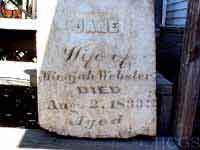New Castle's South 9th Street Cemetery



In the September 13, 1889 issue of the New Castle Courier, William H. Elliot writes about the old abandoned Methodist cemetery that is located in the 100 block on S. 9th Street, where the Wesleyan church is located today. The early burials here were mostly members of the first Methodist church in New Castle, names such as Hobson, Colburn, Carr, Healey, Julian, Webster and others. Several victims of the cholera epidemic are also most likely buried here. Sometime after the turn of the 20th century this cemetery disappeared
and no one remembers what happened to it. Today the church is located on the old cemetery lot. This last Fall I came into possession of two tombstones that were found in an overgrown backyard of a residence in the 900 Block of Spring Street, about six blocks north of the old cemetery. How they ended up there is a complete mystery. One is for Revel Colburn who died on 24 Feb 1844 and the other is for his daughter Jane Colburn Webster who died on 2 Aug 1833 in the cholera epidemic that hit Henry County in the summer of 1833. She was the wife of Micajah Webster, who is also most likely buried here.
New Castle Courier, 1889
[Within the corporate limits of the peaceful municipality of New Castle there stands a cemetery long since grown into disuse. In the western part of the city on a little hillside over looking the valley of the beautiful Blue River, stands this silent city of the dead. Men have built houses beyond the resting places of their ancestors, and the new water works plant is located far out to the west of where it lies in weedy forgetfulness. Here are buried the pioneers who laid the foundations for the future capital of Henry County. Inside the enclosure a thick growth of tangled weeds and grass hide from view the earthly homes of the silent sleepers. The place is overgrown with briars and brambles, and the ground beneath rises and falls like the billows on the ocean. Hidden among the labyrinth, stands gravestones - marble visiting cards left by the pilgrims on their departure on the long journey--- so that they might not be forgotten by mankind. Silent, sepulchral it stands, and the tinkle of the cowbell in the neighboring pasture sounds in musical contrast with the ghost like silence surrounding the forsaken spot.
This place, although uninviting in appearance and secluded in its locality, possesses an interest for some whose curiosity leads them within its limits. Climb over the old fence close beside the unlocked gate whose creaky hinges have long since grown rusty from disuse, stumble over a mound hidden by the rank undergrowth, or fall into a pitfall where the earth is sunken down over the remains of one whose memory is kept green only by the wildflowers blooming above the lonely grave. Pullback the grasses and brush away the moss from the weather stained, time worn headstone. It bears a date that antedates your birth -1829, here, in the years gone by, when New Castle was yet wearing the swaddling clothes of an infant village, unpretentious processions winded their sorrowful way, and deposited in this sacred spot, "where heaves the turf in many a smoldering heap, each in its narrow cell forever laid," the remains of many an honored citizen, pioneer. With growth of the town, the early burying ground became too small and unpretentious. A new cemetery was located, and above the graves stately monuments rear their graceful forms; but here in the old grave yard where "the rude forefathers of the hamlet sleep" still gleam the humble marble slabs above the graves of the honest pioneers; and the secluded spot is still sacred to many yet living.]
|


 Henry County Genealogical Services
Henry County Genealogical Services

